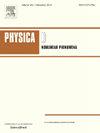A comprehensive review on controlled supersonic jets in improving their mixing characteristics
IF 2.7
3区 数学
Q1 MATHEMATICS, APPLIED
引用次数: 0
Abstract
This article thoroughly reviews the studies on enhancing the mixing and controlling of supersonic jets through passive and active control techniques. At first, the behavior of jets and their interactions with the environment, such as entrainment of surrounding fluid and vortex formation, are explored. Subsequently, the control mechanisms for supersonic jets are described. The impacts of the jet-jet interactions are explicitly demonstrated. The jet behaviors for different nozzle geometries and nozzle lip modification are reviewed, emphasizing the introduction of asymmetry by generating the vortices promoting jet mixing. The asymmetric jets perform better mixing performance than the axisymmetric jets due to the axis-switching behavior and azimuthal asymmetry. The tab-like vortex generators at the nozzle exit and their impact on jet spreading and mixing characteristics are particularly emphasized; different tab shapes, locations, and aspect ratios are reviewed, highlighting their effects on jet mixing and core length reduction. The paper focuses on understanding the behavior of vortices generated by tabs of varying designs and their effect on mixing enhancement. The findings underscore the effectiveness of both passive and active control techniques in promoting jet mixing and reducing core length. Subsequently, the active controls such as fluidic actuators, air tabs, and plasma jets are explored. The main objective of the controlled jet is to introduce additional controlled vortices and to alter the jet instabilities to enhance the interaction between the jet and its surroundings. These strategies lead to enhanced mixing, reduced core length, and are beneficial for jet noise mitigation, combustion augmentation, and the improvement of stealth capabilities.
控制超音速射流在改善其混合特性方面的研究综述
本文综述了通过被动和主动控制技术增强超声速射流混合和控制的研究进展。首先,射流的行为及其与环境的相互作用,如周围流体的夹带和漩涡的形成,进行了探索。随后,介绍了超音速射流的控制机制。射流相互作用的影响得到了明确的证明。综述了不同喷嘴几何形状和喷嘴唇形的射流特性,重点介绍了通过产生促进射流混合的涡流来引入不对称。由于轴向切换特性和方位不对称性,非对称射流比轴对称射流具有更好的混合性能。特别强调了喷嘴出口处的片状涡发生器及其对射流扩散和混合特性的影响;不同的标签形状,位置和纵横比进行了审查,突出其对射流混合和芯长度减少的影响。本文重点研究了不同设计的旋翼所产生的旋翼的特性及其对混合增强的影响。研究结果强调了被动和主动控制技术在促进射流混合和减少岩心长度方面的有效性。随后,探讨了主动控制,如流体致动器、空气片和等离子体射流。受控射流的主要目的是引入额外的受控涡,改变射流的不稳定性,以增强射流与周围环境的相互作用。这些策略可以增强混合,减少核心长度,有利于降低射流噪声,增强燃烧,提高隐身能力。
本文章由计算机程序翻译,如有差异,请以英文原文为准。
求助全文
约1分钟内获得全文
求助全文
来源期刊

Physica D: Nonlinear Phenomena
物理-物理:数学物理
CiteScore
7.30
自引率
7.50%
发文量
213
审稿时长
65 days
期刊介绍:
Physica D (Nonlinear Phenomena) publishes research and review articles reporting on experimental and theoretical works, techniques and ideas that advance the understanding of nonlinear phenomena. Topics encompass wave motion in physical, chemical and biological systems; physical or biological phenomena governed by nonlinear field equations, including hydrodynamics and turbulence; pattern formation and cooperative phenomena; instability, bifurcations, chaos, and space-time disorder; integrable/Hamiltonian systems; asymptotic analysis and, more generally, mathematical methods for nonlinear systems.
 求助内容:
求助内容: 应助结果提醒方式:
应助结果提醒方式:


